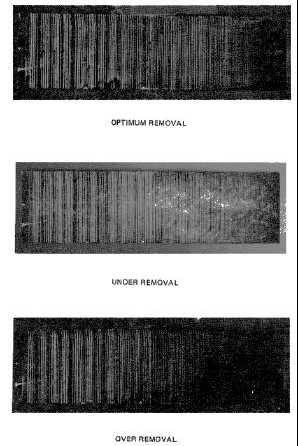T.O. 33B-1-1
2-60
Figure 2-21. The Effects of Optimum, Insufficient, and Excessive Hydrophilic Removal.
2.5.5.5.1
Another advantage of hydrophilic remover is its relative insensitivity to removal of penetrant entrapped in a
discontinuity. This permits complete removal of fluorescent background in most cases. In contrast, when using
lipophilic emulsifier on slightly rough surfaces, it is desirable to leave a faint residual background when maximum
sensitivity is required. The reduction of background fluorescence with the hydrophilic technique improves the contrast,
making faint indications easier to see. The hydrophilic method also allows spot or touch-up removal on local areas
during the final clear water rinse. This cannot be done with the lipophilic method, since the oil base emulsifier will not
tolerate water. The use of hydrophilic emulsifiers also provides better control, handling and recycling of the penetrant
effluent. This can significantly decrease waste water treatment costs and minimize water pollution.
Table 2-4. Comparison of Hydrophilic versus Lipophilic Methods.
Hydrophilic
Lipophilic
1. Supplied as a concentrate
1. Supplied as a ready to use fluid
2. Water base when mixed
2. Oil base
3. Low viscosity 9 to 12 cs
3. High viscosity 35 to 120 cs
4. Limited penetrant tolerance
4. Miscible with penetrant in all concentrations
5. Miscible with water in all concentrations
5. Limited water tolerance
6. Applied as dip or spray
6. Applied as a dip
7. Action: Dip-detergent with scrubbing wash
7. Action: Diffusion activated by scrubbing
8. Reduced drag-out
8. Critical emulsion time

